Torahluminations by Peter Asher Pitzele
Whence an image? The awesome power of visual art unleashes meaning, complex and subtle. No wonder halacha warned us of its destructive power in false worship. And yet we are driven to explore its permissible borders, wondering how to conceive of our narratives and unlock their mysteries in two and three dimensions. Artist Peter Asher Pitzele strives with his work to “open the mind’s eye” even as it gives us sensual pleasure.
Intellect, commentary and a visual feast are all offered in his recent works (2007-2010) of paper collages seen in this exhibition, and also recently at the South Huntington Public Library and on his website, biblioartist.com.
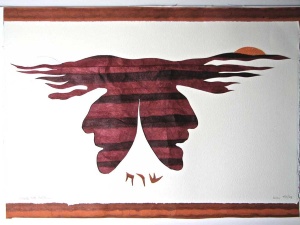
In Two Worlds: Serach puzzles us with a symbolic representation of Asher’s daughter first mentioned in Genesis 46:17. Curiously she is again mentioned in Numbers 26:46 as one of the Israelites who went out from Egypt, hundreds of years later and hereby becoming the oldest woman in the Torah. The midrash explains her longevity by relating her artful kindness when, at the bidding of her uncles, Jacob’s sons, she played her harp and gently sang to her grandfather Jacob that indeed Joseph was still alive and ruler of all Egypt. The grateful patriarch blessed her saying “may you live forever and never die.”
As poetic a story as that is, it doesn’t explain why the artist depicts her in Janus-like double profile with her hair flowing from moon rise to sun rise. That is until one looks into the midrashim a bit deeper. Serach’s grace, wisdom and memory served the Israelites well over the years. The Midrash Rabba tells us that when Moses appears as a liberator, she reminded the Jews that indeed God had promised Jacob that they would be freed one day from Egyptian bondage. Her sharp memory was legendary, directing Moses exactly where the Egyptians had buried Joseph’s lead casket in the Nile and even reminding the sages generations later exactly how the waters of the Red Sea looked when they parted (Pesikta de Rav Kahana 11:13).
Pitzele’s depiction of Serah now comes into sharper focus. The double-faced Janus, an ancient Roman deity reflected in the month January, represents beginnings and by inference, endings. He looks forward and backward expressing the future and the past, the very embodiment of memory, just as Serah was fated with Jacob’s blessing to live forever and never forget.
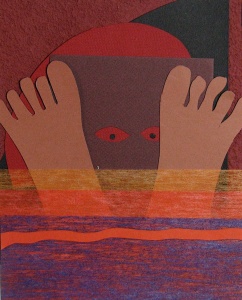
On a much lighter note Ruth and Boaz evokes the shock and surprise experienced by the awakened Boaz when Ruth uncovers his feet on the threshing floor, thereby announcing her availability for marriage. Two dumbfounded red eyes peer at us between two bare feet creating the astonishing transformation of the each and every viewer into Ruth herself. Witty and clever, the artist has thrust us into the heart of the narrative.
Peter Pitzele has a whole other life that deeply influences his artwork. He has a PhD in Literature from Harvard and has over the years taught literature, therapeutic theater and psychodrama exploring many aspects of contemporary midrash. Most recently he has developed Bibliodrama, a method of utilizing improvisational drama directed to deepen biblical learning and commentary.
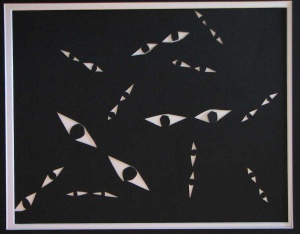
Spies is at once simple and foreboding. Twelve stylized pairs of eyes peer at us out of the pitch-black darkness creating an enticing pattern better suited to a cartoon drama. And yet the humor soon fades as we meditate on the awesome consequences of the ten tribal leaders lack of faith in our imminent entry into the Land of Israel. As a result an entire generation was doomed to die in the wilderness and we still are condemned to mourn the loss of our Temple each and every year. There is nothing funny in these eyes staring out of their black tragic fate.
His artworks must be closely examined to fully appreciate the complexity and richness of the images Pitzele produces. Central to his technique is creating subtle textures to lure us into a visual dialogue with the works. In his simpler works he utilizes a wide array of colored papers, rice paper, and cardboards, solid, translucent, torn, cut and pasted. Other works feature gold and silver foil, printed material and some fuzzy fabric weaving flattened into becoming an illusionistic pattern. At times the textures are real and at others they are photocopies, constantly suspending us between illusion and reality. Finally text, English and Hebrew, is selectively incorporated as title, patterns or combinations of both.
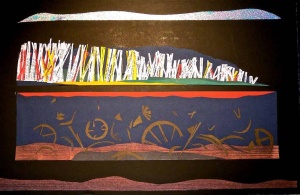
Sea of Reeds purposefully mixes its metaphors, allowing the Israelites to simultaneously march on dry land while visually suspended over the watery deep clogged with the destroyed chariots of Pharaoh’s army. To push the image even further the artist depicts the joyous Israelites as vertical strips of white, yellow and red text from the Song at the Sea, literally conflating the Jews with their most thankful praise to their God. Adding to the richness of text and color are the horizontal strips of patterned paper and iridescent material sky at the top glowing lavender and blue. The complexity summons up an expansive view of our liberation and joy.
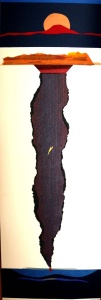
It is perhaps the lush attention to detail and texture that brings out a poetic reaction on the part of the viewer. Nonetheless, Pitzele’s work can be deadly serious. Isaac’s Well is a case in point. A roughly ripped “V” dominates the composition, plunging into the earth with a little drop of blood penetrating the lower blue waters. Far above is a smoldering rocky plateau that floats beneath a fiery red mountain and orange sun. The symbolism is immediately apparent; the jagged knife-like shape of the well beneath a mountain summons the drama of the Akeidah. But this seems to contradict the title of “Isaac’s Well.” Now the tiny yellow knife falling down in the middle of the well snaps the image into an alternative narrative. Pitzele’s vision is no less than a radical re-understanding of the otherwise normative episodes of Isaac’s wells. Textually Isaac’s re-digging of his father’s wells simply reasserts his territorial authority in Philistine Gerar established by Abraham. But here the well becomes a vessel into which Isaac is compelled to dispose of the symbolic object of his terror, the knife that almost ended his life and first introduced him to his father’s God. The artist asserts that generically wells are both for substance and for disposing of that which is untenable. Surely the constant terror Isaac had been taught (and has passed on to us) was something he would have been more than happy to toss down the well of history. It was not to be, but Pitzele movingly provides us with an image of our wishful thinking.
Peter Asher Pitzele has immersed himself in Torah and midrashim and through his Bibliodrama, found many hidden voices in the simplest of materials, becoming a “biblical storyteller” with “papery transformations.” His explorations have indeed opened up the mind’s eye to an unexplored level of Jewish meaning in our sacred narratives.
Torahluminations by Peter Asher Pitzele
Hebrew Union Collage – Jewish Institute of Religion Museum
One West 4th Street, New York, NY
Biblioartist.com